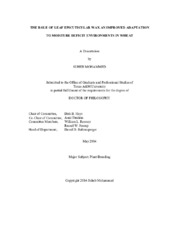The Role of Leaf Epicuticular Wax an Improved Adaptation to Moisture Deficit Environments in Wheat
Abstract
Water deficiency is the primary reason for decreasing wheat (Triticum aestivum)
yields globally, causing a nearly 50-90% yield reduction on at least 60 Mha of land in
developing countries Previous studies have identified associations in genomic regions
for cooler canopies, heat susceptible index, and grain yield components in winter wheat.
This project aims to define the role that leaf epicuticular wax (EW) plays as a drought
adaptive trait in terms of yield stability. A spring wheat Len/Halberd recombinant inbred
line population was used to test this question. The RIL population exhibits significant
segregation for leaf EW, canopy temperature (CT), awns, and drought susceptible index
(DSI) yet has been selected. An alpha lattice design with 180 recombinants and 2
replications was used with two distinct treatments (water deficit and control conditions)
at each of 5 environments. The inheritance of leaf EW was low (15%) due to a high
environmental influence. The RILs grown under water deficit produced significantly
higher EW content (19 to 30%) when compared to control. The leaf EW load
significantly correlated with plot yield (r=32%), DSI (r=-40%), and leaf CT (r=-32%)
under water deficit conditions. In addition, EW and CT correlated with higher yield
stability using DSI and across environments using Eberhart stability under water deficit.
Novel and robust co-localized QTLs for the leaf EW, cooler canopies, DSI, and grain
attributes were detected on 2B, 3B, 5A, 5B, 6B, 7A, and 7B. High LOD scores and colocalization
of CT and DSI along with independent EW loci explaining 35%, 41%, and
31% phenotypic variation respectively were detected on chromosome 4A. Chromosome 3B was investigated with closed association of leaf EW and canopy temperature all across the chromosomal length. Chromosome 6B had significant SNPs associated with cooler canopies in Halberd (2.4ºС) compared to Len. The Halberd parent played a role in donating major alleles for moisture stress tolerance whereas, Len donates major yield allelic variants. Many novel and robust QTLs were identified to dissect the crop performance under moisture stress conditions. These identified genetic loci conducive potential tools in strategic breeding approaches.
Subject
Drought susceptible indexHeat susceptible index
Epicuticular wax
Canopy temperature
Mean single head weight
Kernel number per spike
Thousand kernel weight
Quantitative trait loci
Recombinant inbred lines
Citation
Mohammed, Suheb (2014). The Role of Leaf Epicuticular Wax an Improved Adaptation to Moisture Deficit Environments in Wheat. Doctoral dissertation, Texas A & M University. Available electronically from https : / /hdl .handle .net /1969 .1 /152620.


